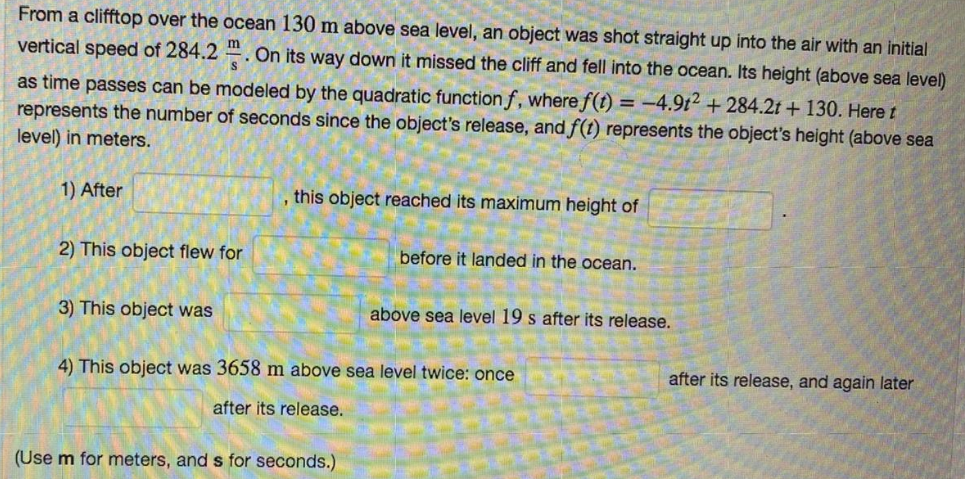From a clifftop over the ocean 130 m above sea level, an object was shot straight up into the air with an initial vertical speed of 284.2 . On its way down it missed the cliff and fell into the ocean. Its height (above sea level) as time passes can be modeled by the quadratic functionf, where f(t) = -4.9t² + 284.2t + 130. Here t represents the number of seconds since the object's release, and f(t) represents the object's height (above sea level) in meters.
From a clifftop over the ocean 130 m above sea level, an object was shot straight up into the air with an initial vertical speed of 284.2 . On its way down it missed the cliff and fell into the ocean. Its height (above sea level) as time passes can be modeled by the quadratic functionf, where f(t) = -4.9t² + 284.2t + 130. Here t represents the number of seconds since the object's release, and f(t) represents the object's height (above sea level) in meters.
Functions and Change: A Modeling Approach to College Algebra (MindTap Course List)
6th Edition
ISBN:9781337111348
Author:Bruce Crauder, Benny Evans, Alan Noell
Publisher:Bruce Crauder, Benny Evans, Alan Noell
Chapter2: Graphical And Tabular Analysis
Section2.1: Tables And Trends
Problem 1TU: If a coffee filter is dropped, its velocity after t seconds is given by v(t)=4(10.0003t) feet per...
Related questions
Question

Transcribed Image Text:From a clifftop over the ocean 130 m above sea level, an object was shot straight up into the air with an initial
vertical speed of 284.2
s'
On its way down it missed the cliff and fell into the ocean. Its height (above sea level)
as time passes can be modeled by the quadratic functionf, where f(t) = -4.9t2 + 284.2t + 130. Here t
represents the number of seconds since the object's release, and f(t) represents the object's height (above sea
level) in meters.
1) After
this object reached its maximum height of
2) This object flew for
before it landed in the ocean.
3) This object was
above sea level 19 s after its release.
4) This object was 3658 m above sea level twice: once
after its release, and again later
after its release.
(Use m for meters, and s for seconds.)
Expert Solution
This question has been solved!
Explore an expertly crafted, step-by-step solution for a thorough understanding of key concepts.
This is a popular solution!
Trending now
This is a popular solution!
Step by step
Solved in 2 steps with 2 images

Knowledge Booster
Learn more about
Need a deep-dive on the concept behind this application? Look no further. Learn more about this topic, algebra and related others by exploring similar questions and additional content below.Recommended textbooks for you

Functions and Change: A Modeling Approach to Coll…
Algebra
ISBN:
9781337111348
Author:
Bruce Crauder, Benny Evans, Alan Noell
Publisher:
Cengage Learning


College Algebra (MindTap Course List)
Algebra
ISBN:
9781305652231
Author:
R. David Gustafson, Jeff Hughes
Publisher:
Cengage Learning

Functions and Change: A Modeling Approach to Coll…
Algebra
ISBN:
9781337111348
Author:
Bruce Crauder, Benny Evans, Alan Noell
Publisher:
Cengage Learning


College Algebra (MindTap Course List)
Algebra
ISBN:
9781305652231
Author:
R. David Gustafson, Jeff Hughes
Publisher:
Cengage Learning


Algebra & Trigonometry with Analytic Geometry
Algebra
ISBN:
9781133382119
Author:
Swokowski
Publisher:
Cengage

Glencoe Algebra 1, Student Edition, 9780079039897…
Algebra
ISBN:
9780079039897
Author:
Carter
Publisher:
McGraw Hill